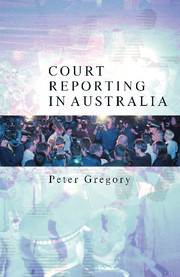Book contents
- Frontmatter
- Contents
- Figures and Tables
- Acknowledgments
- Introduction
- Chapter 1 The Court System: An Overview
- Chapter 2 Gaining Information
- Chapter 3 Contempt
- Chapter 4 Defamation
- Chapter 5 Writing the (Newspaper) Story
- Chapter 6 Subediting and Photography
- Chapter 7 Television and Radio
- Chapter 8 Human Relations and Ethics
- Chapter 9 An Atypical Friday at Court
- Chapter 10 Suppression Orders
- Chapter 11 Future Directions and Issues
- Bibliography
- Index
Chapter 1 - The Court System: An Overview
Published online by Cambridge University Press: 22 September 2009
- Frontmatter
- Contents
- Figures and Tables
- Acknowledgments
- Introduction
- Chapter 1 The Court System: An Overview
- Chapter 2 Gaining Information
- Chapter 3 Contempt
- Chapter 4 Defamation
- Chapter 5 Writing the (Newspaper) Story
- Chapter 6 Subediting and Photography
- Chapter 7 Television and Radio
- Chapter 8 Human Relations and Ethics
- Chapter 9 An Atypical Friday at Court
- Chapter 10 Suppression Orders
- Chapter 11 Future Directions and Issues
- Bibliography
- Index
Summary
Courts are society's mechanism for enforcing its laws. Their purpose is to protect individuals and their property, to let our economic and parliamentary frameworks operate and protect the community as a whole. The Australian legal system, based on British law, is commonly called a hierarchical one. Minor cases, like small thefts and assault, or less serious breaches of traffic rules, are heard at one end of the system, usually called Magistrates or Local courts. At the other end, the High Court hears constitutional arguments and is the final appeal court for Australian cases. Parliaments make laws; so do judges by the decisions they make in court. Court-made law is otherwise known as common law. Laws have been developed to handle perceived breaches of rules and a variety of other disputes. Criminal courts hear evidence, make decisions and impose sanctions for offences ranging from parking fines to murder and treason. Civil hearings deal with arguments over contracts and non-criminal wrongs by one party resulting in loss or harm to another. Claims for compensation for personal injury caused by negligence or damage to reputation from defamation fall into this category. Family break-ups and the surrounding issues are another. A range of behaviour involving children is administered by a separate court, although the more serious offences can be heard in the adult system. Commonwealth laws, deaths, financial and broadcasting cases and migration debates are all covered within the court hierarchy.
- Type
- Chapter
- Information
- Court Reporting in Australia , pp. 5 - 13Publisher: Cambridge University PressPrint publication year: 2005



